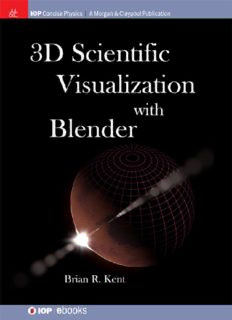Table Of Content3D Scientific Visualization
®
with Blender
Brian R Kent, PhD
National Radio Astronomy Observatory, Charlottesville, VA, USA
Morgan & Claypool Publishers
Copyright © 2015 Morgan & Claypool Publishers All rights reserved. No part of
this publication may be reproduced, stored in a retrieval system or transmitted in
any form or by any means, electronic, mechanical, photocopying, recording or
otherwise, without the prior permission of the publisher, or as expressly
permitted by law or under terms agreed with the appropriate rights organization.
Multiple copying is permitted in accordance with the terms of licences issued by
the Copyright Licensing Agency, the Copyright Clearance Centre and other
reproduction rights organisations.
Rights & Permissions
To obtain permission to re-use copyrighted material from Morgan & Claypool
Publishers, please contact [email protected].
ISBN 978-1-6270-5612-0 (ebook)
ISBN 978-1-6270-5611-3 (print)
ISBN 978-1-6270-5614-4 (mobi) DOI 10.1088/978-1-6270-5612-0
Version: 20150301
IOP Concise Physics
ISSN 2053-2571 (online)
ISSN 2054-7307 (print) A Morgan & Claypool publication as part of IOP
Concise Physics
Published by Morgan & Claypool Publishers, 40 Oak Drive, San Rafael, CA,
94903, USA IOP Publishing, Temple Circus, Temple Way, Bristol BS1 6HG,
UK
This book is dedicated to Linda Kent.
Contents
Preface
Acknowledgments
Author biography
1 Introduction
1.1 Visualization in the sciences
1.2 What is Blender?
1.3 Rendering engines
1.4 Community support
1.5 Types of data visualization in the sciences
Bibliography
2 The interface and windowing set-up
2.1 Interface introduction
2.1.1 3D view port
2.1.2 Using the keyboard
2.1.3 Quad view
2.1.4 UV-view
2.1.5 Object tools toolbar
2.1.6 Transform toolbar
2.1.7 Data outliner
2.1.8 Properties panel
2.1.9 Animation time line
2.2 Windowing set-up for Python
2.3 Data types and Python modules
2.4 Python libraries
Bibliography
3 Meshes, models and textures
3.1 Structure of 3D mesh objects
3.1.1 Example: building a simple model
3.2 2D materials and textures
3.2.1 Example: adding a texture to a sphere
3.3 3D materials and textures
3.3.1 Example: creating points for a 3D scatter plot
3.3.2 Example: creating a wireframe mesh
Bibliography
4 Lighting
4.1 Lighting and color selection in Blender
4.1.1 Example: how to illuminate simulated terrain
4.1.2 Material emission
Bibliography
5 Animation
5.1 Keyframes
5.1.1 Example: how to rotate and animate an object
5.1.2 Example: using the graph editor
5.1.3 Example: adding a cyclic modifier
5.2 Frame rates and rendering output
5.2.1 Output formats
5.3 Node compositing
6 Point of view: camera control
6.1 Projection differences: a matter of perspective
6.2 Camera keyframes
6.2.1 Example: tracking to an object
6.2.2 Example: an object following a path
Bibliography
7 Python scripting
7.1 Scripting in blender
7.1.1 Blender and Python libraries
7.1.2 Example: reading formatted ASCII data into blender
7.1.3 Example: adding data points to an object as vertices
7.1.4 Example: animating multiple time steps
8 Projects and 3D examples
8.1 3D scatter plot
8.2 N-body simulation
8.3 Magnetic fields
8.4 Lagrangian equilibrium and zero-velocity curves
8.5 Geophysics: planetary surface mapping
8.6 Volumetric rendering and data cubes
8.7 Physics module and rigid body dynamics
Bibliography
Appendix A Blender keyboard shortcuts
Preface
Observations, experiments and simulations in the sciences often have high
impact visuals that never cease to provide insight into the Universe. This book is
the result of exploring comprehensive software packages in 3D visualization for
research in astronomy and astrophysics. Surveying the broader scope of a variety
of scientific fields, we can see that the incredible results of our experiments can
benefit in communicating results to both the scientific community as well as a
broader audience.
This book is intended for the individual investigator or ambitious student to
begin learning the fundamentals of 3D visualization for science. We utilize
Blender, an agile and comprehensive software package for data visualization and
animation. The application programming interface allows scientists to import
and manipulate their data through the Python language. After introducing the
fundamentals, the book concludes with a number of illustrative projects to bring
various components together culminating in a series of visualizations.
A website1 is also available as a companion to the book with example files
and videos providing the user with step-by-step instructions on principles and
projects outlined in the text. It is my hope that these will serve as a launching
point for scientists to take their data visualizations to the next level.
1www.cv.nrao.edu/~bkent/blender/
Acknowledgments
Blender® is a registered trademark of the Blender Foundation. The author would
like to thank Matthew Wood for directing me to the IOP Concise Physics series
with Jeanine Burke and Joel Claypool of Morgan & Claypool Publishers, David
Thomas for the Lagrange point calculations and Linda Kent for her
encouragement. Members of the astronomical community and ACM
SIGGRAPH conference provided useful queries that helped in developing the
ideas of this book. The National Radio Astronomy Observatory is a facility of
the National Science Foundation operated under cooperative agreement by
Associated Universities, Inc.
Author biography
Brian R Kent
Brian R Kent, PhD is a scientist with the National Radio Astronomy
Observatory in Charlottesville, Virginia. His publications and studies in
astrophysics and computing include scientific visualizations of a variety of
theoretical and observational phenomena. He is interested in visualizing data for
scientific analysis as well as reaching a broad audience with the stunning visuals
that modern 3D graphics can provide. Dr Kent received his PhD in Astronomy
and Space Sciences from Cornell University. His website is:
http://www.cv.nrao.edu/~bkent/
Description:This is the first book written on using Blender (an open-source visualization suite widely used in the entertainment and gaming industries) for scientific visualization. It is a practical and interesting introduction to Blender for understanding key parts of 3D rendering that pertain to the sciences

